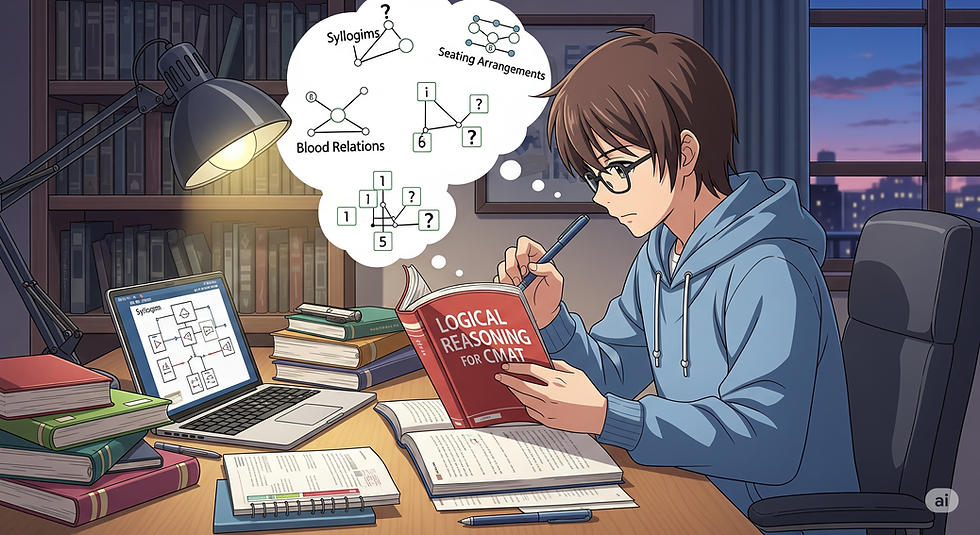Reading Comprehension Question for CAT (Basic - 6)
- Jul 22
- 7 min read

Read the following passage and answer the questions that follow:
Read the passage carefully and answer the questions that follow:
Online learning and traditional classroom education each have distinct advantages and challenges. Online learning offers flexibility, allowing students to learn at their own pace and access a vast range of resources from anywhere. This model is particularly beneficial for working professionals, individuals with disabilities, and those in remote areas. Additionally, online courses often incorporate interactive elements like discussion forums, quizzes, and video lectures, making education more accessible and self-directed.
Traditional classroom education, on the other hand, provides a structured learning environment with direct teacher-student interaction. The physical presence of instructors and peers fosters engagement, immediate feedback, and collaborative learning. Hands-on activities, group discussions, and social interactions contribute to a richer educational experience, which can be difficult to replicate in an online setting. Moreover, traditional classrooms help students develop discipline and time management through fixed schedules and deadlines.
While both approaches have merit, the choice depends on individual needs and learning styles. Some students thrive in a self-paced online environment, while others require the discipline and social engagement of a classroom. Instead of viewing them as competing models, a blended approach that integrates online resources with in-person instruction could maximize the benefits of both. As technology advances, education systems may increasingly combine these methods, creating more personalized and effective learning experiences.
Q.1 Which of the following, if true, would most weaken the argument that a blended learning approach is ideal?
a.Some universities have successfully eliminated classroom-based instruction without any negative impact on student outcomes.
b.Many students find it difficult to transition between online and in-person learning, leading to inconsistent academic performance.
c.Institutions that rely only on online learning have seen increased student enrollment in recent years.
d.Online learning platforms have become more interactive, reducing the need for face-to-face instruction.
Q.2 Which of the following best captures the central argument presented in the passage?
a.The most effective educational model would combine elements of both online and traditional learning to maximize their respective advantages.
b.Online and traditional education are fundamentally incompatible, requiring students to choose one over the other.
c.Traditional classroom education is more effective than online learning because of direct interactions and structured learning environments.
d.Online learning is a superior alternative to traditional classroom education due to its flexibility and accessibility.
Q.3 Which of the following can be reasonably inferred from the passage?
a.Traditional classroom education is outdated and will soon be entirely replaced by online learning.
b.The effectiveness of a learning model depends primarily on the subject being taught rather than the learning style of students.
c.Online education is best suited for people who cannot attend traditional classrooms due to personal or geographical constraints.
d.Online learning eliminates the need for in-person interactions in education.
Q.4 Which of the following statements would most strengthen the argument made in the passage?
a.Many educational institutions are hesitant to adopt online learning because they lack the necessary technological infrastructure.
b.Students who have access to both online and classroom learning tend to perform better than those who rely on only one mode of education.
c.The cost of implementing blended learning models is significantly higher than choosing only one form of education.
d.Employers prefer candidates who have completed their education in traditional classroom settings over those who studied online.
Read the passage carefully and answer the questions that follow:Minimalism has emerged as a powerful movement reshaping modern lifestyles. In a world overwhelmed by consumerism, minimalism promotes intentional living by encouraging people to own fewer but more meaningful possessions. It is not just about decluttering physical spaces but also about simplifying commitments, digital interactions, and daily routines. By focusing on essentials, individuals often experience reduced stress, improved mental clarity, and greater financial freedom.
The shift toward minimalism is fueled by the desire to escape the endless cycle of materialism. Advertising and social pressure constantly push the idea that more is better, yet many find that excessive consumption leads to dissatisfaction rather than fulfillment. Minimalism challenges this mindset by shifting focus from acquiring goods to valuing experiences, relationships, and personal growth. As people prioritize what genuinely adds value to their lives, they often find a deeper sense of contentment.
This lifestyle choice also intersects with sustainability. Owning fewer items reduces waste, lowers environmental impact, and discourages mindless consumption. Many who embrace minimalism opt for durable, high-quality products rather than disposable ones, making it a conscious step toward a more responsible way of living. The influence of minimalism extends beyond personal benefits; it reflects a broader cultural shift toward mindful decision-making in an era of excess.
As the movement grows, minimalism is reshaping industries, from fashion to technology, pushing companies to offer more sustainable and functional products. It is less about restriction and more about freedom—the freedom to live with intention, unburdened by the unnecessary, and to find fulfillment in simplicity rather than abundance.
Q.5 Which of the following would most challenge the claims made in the passage?
a.The popularity of minimalism has resulted in increased production of minimalist-style consumer goods.
b.Most people who embrace minimalism do so temporarily before returning to materialistic habits.
c.Minimalism has had no real impact on industries, as businesses continue to focus on mass production and advertising.
d.Many individuals who attempt to embrace minimalism find it difficult to maintain over time.
Q.6 Which of the following would best support the argument presented in the passage?
a.More people adopting minimalism have reported feeling a greater sense of purpose and mental clarity.
b.Real estate companies encouraging people to buy larger homes with more storage space.
c.Governments imposing regulations to limit the production of consumer goods.
d.High-end luxury brands introducing more expensive, limited-edition products.
Q.7 What can be reasonably inferred from the passage?
a.Companies have resisted minimalism because it threatens their business models.
b.People embracing minimalism do so primarily for financial reasons rather than for mental or environmental benefits.
c.Minimalism encourages a mindset shift from material acquisition to prioritizing experiences and personal well-being.
d.Minimalism is only relevant in wealthier societies where individuals can afford to reject consumerism.
Q.8 Which of the following best captures the core argument of the passage?
a.The rise of minimalism is driven by a rejection of material excess, emphasizing meaningful living and sustainability.
b.Consumerism and advertising have made minimalism an impractical lifestyle choice for most people.
c.Minimalism is primarily a trend in the fashion and technology industries rather than a broader lifestyle shift.
d.Minimalism is a movement focused solely on reducing material possessions to improve financial stability.
Read the passage carefully and answer the questions that follow:
The rise of the gig economy has reshaped the way people approach work, offering flexibility and independence that traditional employment often lacks. Freelancers, independent contractors, and gig workers can choose their schedules, take on multiple projects, and explore diverse opportunities without being tied to a single employer. This shift has been driven by technological advancements, digital platforms, and changing workforce expectations.
While the gig economy offers many benefits, it also brings challenges. Unlike traditional jobs, gig work does not always provide job security, health benefits, or retirement plans. Workers must manage their own finances, navigate unpredictable income streams, and constantly seek new opportunities to maintain stability. These factors create a stark contrast between gig work and traditional employment, where salaries, benefits, and structured career growth are more common.
Businesses have also adapted, relying more on gig workers to reduce costs and maintain a flexible workforce. While this allows companies to scale efficiently, it raises concerns about worker rights, fair wages, and long-term employment prospects. Governments and policymakers face the challenge of balancing innovation in work structures with ensuring protections for gig workers.
As the gig economy continues to grow, traditional employment models must evolve. Companies may need to rethink job structures, offering more flexible work arrangements while maintaining employee benefits. Workers, in turn, will need to weigh the advantages of independence against the security of traditional jobs. The future of work will likely blend elements of both systems, shaping an employment landscape that is more adaptable to individual and business needs.
Q.9 Which of the following options does NOT support the central argument of the passage?
a.Independence is necessary but not sufficient for achieving real freedom.
b.True freedom requires both internal and external liberty.
c.Independent individuals are always free to make any choices they want.
d.Many nations remain unfree despite gaining political independence.
Q.10 Which of the following options does NOT weaken the argument made in the passage?
a.Many people in post-colonial nations report high levels of satisfaction and autonomy.
b.Some societies without formal independence have thriving communities with strong freedoms.
c.Freedom and independence are just two words for the same idea and are used interchangeably by experts.
d.Studies show that mental conditioning can limit a person's decision-making even in independent environments.
Q.11 Based on the passage, which of the following can be logically inferred?
a.The gig economy will eventually lead to the disappearance of permanent employment.
b.Workers in the gig economy need to develop financial management skills to ensure stability.
c.Companies that rely on gig workers do not care about employee well-being.
d.Governments are unwilling to address the challenges posed by the gig economy.
Q.12 Which of the following, if true, would further support the argument presented in the passage?
a.Companies that offer flexible work options along with benefits experience higher employee satisfaction.
b.Gig workers report lower stress levels than traditional employees due to the freedom of choosing projects.
c.Businesses using gig workers reduce operational costs significantly compared to those relying on full-time employees.
d.The majority of gig workers transition to full-time jobs within a year of entering the gig economy.
Q.13 Which of the following statements CANNOT be inferred from the passage?
a.A person can be financially independent but emotionally constrained.
b.Some governments may restrict freedoms even after gaining political independence.
c.Freedom is solely determined by the presence of independence.
d.Structural reforms are necessary to create a society that values freedom.
Q.14 Which of the following, if true, would cast doubt on the claims made in the passage?
a.Many companies that initially relied on gig workers have reverted to traditional employment models.
b.Gig workers who achieve financial stability often choose to remain in freelance roles rather than seek permanent jobs.
c.Countries that have heavily regulated gig work have seen a decrease in worker participation.
d.Employees in traditional jobs are increasingly dissatisfied with the rigid structures of full-time employment.
Q.15 What is the primary objective of the passage?
a.To explore the legal implications of gaining independence.
b.To highlight the need for both independence and freedom in achieving genuine autonomy.
c.To promote the celebration of independence movements around the world.
d.To examine how independence can guarantee freedom for individuals.
Q.16 Which of the following best represents the core argument of the passage?
a.The gig economy is replacing traditional jobs and making full-time employment obsolete.
b.The growth of the gig economy presents both opportunities and challenges for workers and businesses.
c.Traditional employment remains superior to gig work due to its benefits and security.
d.Digital platforms are responsible for the rise of gig work and the decline of traditional employment.
1 | 2 | 3 | 4 | 5 | 6 | 7 | 8 |
B | A | C | B | A | A | C | A |
9 | 10 | 11 | 12 | 13 | 14 | 15 | 16 |
C | D | B | A | C | A | B | B |






Comments